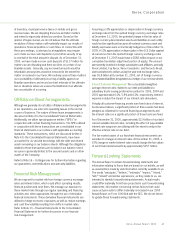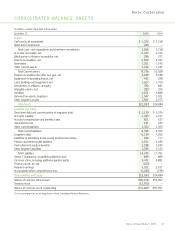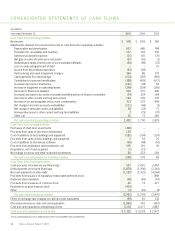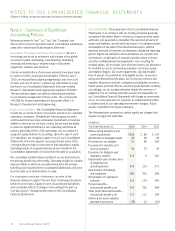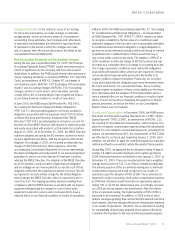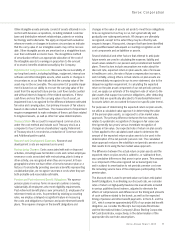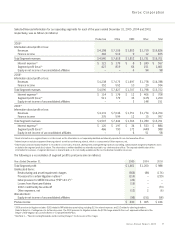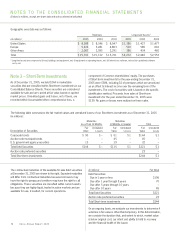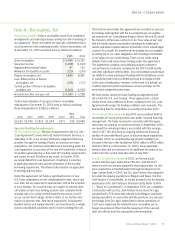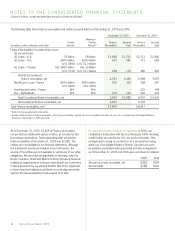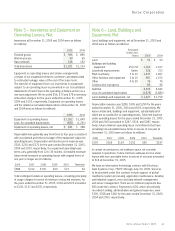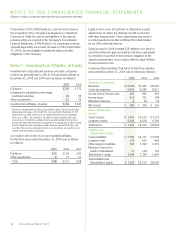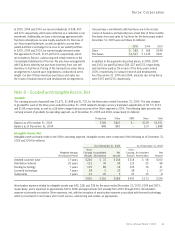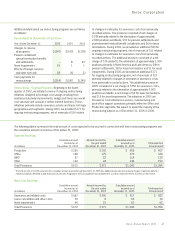Xerox 2005 Annual Report Download - page 63
Download and view the complete annual report
Please find page 63 of the 2005 Xerox annual report below. You can navigate through the pages in the report by either clicking on the pages listed below, or by using the keyword search tool below to find specific information within the annual report.
Xerox Corporation
55
Other intangible assets primarily consist of assets obtained in con-
nection with business acquisitions, including installed customer
base and distribution network relationships, patents on existing
technology and trademarks. We apply an impairment evaluation
whenever events or changes in business circumstances indicate
that the carry value of our intangible assets may not be recover-
able. Other intangible assets are amortized on a straight-line basis
over their estimated economic lives. The straight-line method
of amortization reflects an appropriate allocation of the cost of
the intangible assets to earnings in proportion to the amount
of economic benefits obtained annually by the Company.
Impairment of Long-Lived Assets: We review the recoverability of
our long-lived assets, including buildings, equipment, internal-use
software and other intangible assets, when events or changes in
circumstances occur that indicate that the carrying value of the
asset may not be recoverable. The assessment of possible impair-
ment is based on our ability to recover the carrying value of the
asset from the expected future pre-tax cash flows (undiscounted
and without interest charges) of the related operations. If these
cash flows are less than the carrying value of such asset, an
impairment loss is recognized for the difference between estimated
fair value and carrying value. Our primary measureof fair value is
based on discounted cash flows. The measurement of impairment
requires management to make estimates of these cash flows related
to long-lived assets, as well as other fair value determinations.
Treasury Stock: We account for repurchased common stock
under the cost method and include such Treasury stock as a
component of our Common shareholders’ equity.Retirement
of Treasury stock is recorded as a reduction of Common stock
and Additional paid-in-capital.
Research and Development Expenses: Research and
development costs are expensed as incurred.
Restructuring Charges: Costs associated with exit or disposed
activities, including lease termination costs and certain employee
severance costs associated with restructuring, plant closing or
other activity,are recognized when they are incurred. In those
geographies where we have either a formal severance plan or a
history of consistently providing severance benefits representing
asubstantive plan, we recognize severance costs when they are
both probable and reasonably estimable.
Pension and Post-retirement Benefit Obligations: We sponsor
pension plans in various forms in several countries covering
substantially all employees who meet eligibility requirements.
Post-retirement benefit plans cover primarily U.S. employees for
retirement medical costs. As permitted by existing accounting
rules, we employ a delayed recognition feature in measuring
the costs and obligations of pension and post-retirement benefit
plans. This requires changes in the benefit obligations and
changes in the value of assets set aside to meet those obligations
to be recognized not as they occur, but systematically and
gradually over subsequent periods. All changes are ultimately
recognized, except to the extent they may be offset by sub-
sequent changes. At any point, changes that have been identified
and quantified await subsequent accounting recognition as net
cost components and as liabilities or assets.
Several statistical and other factors that attempt to anticipate
future events are used in calculating the expense, liability and
asset values related to our pension and post-retirement benefit
plans. These factors include assumptions we make about the
discount rate, expected return on plan assets, rate of increase
in healthcare costs, the rate of future compensation increases,
and mortality, among others. Actual returns on plan assets are
not immediately recognized in our income statement, due to the
delayed recognition requirement. In calculating the expected
return on the plan asset component of our net periodic pension
cost, we apply our estimate of the long-term rate of return to the
plan assets that support our pension obligations, after deducting
assets that are specifically allocated to Transitional Retirement
Accounts (which are accounted for based on specific plan terms).
For purposes of determining the expected return on plan assets,
we utilize a calculated value approach in determining the value
of the pension plan assets, as opposed to a fair market value
approach. The primary difference between the two methods
relates to systematic recognition of changes in fair value over
time (generally two years) versus immediate recognition of
changes in fair value. Our expected rate of return on plan assets
is then applied to the calculated asset value to determine the
amount of the expected return on plan assets to be used in the
determination of the net periodic pension cost. The calculated
value approach reduces the volatility in net periodic pension cost
that results from using the fair market value approach.
The difference between the actual return on plan assets and the
expected return on plan assets is added to, or subtracted from,
any cumulative differences that arose in prior years. This amount
is a component of the unrecognized net actuarial (gain) loss
and is subject to amortization to net periodic pension cost over
the remaining service lives of the employees participating in the
pension plan.
The discount rate is used to present-value our future anticipated
benefit obligations. In estimating our discount rate, we consider
rates of return on high-quality fixed-income investments included
in various published bond indexes, adjusted to eliminate the
effects of call provisions and differences in the timing and amounts
of cash outflows related to the bonds, as well as the expected
timing of pension and other benefit payments. In the U.S. and the
U.K., which comprise approximately 81% of our projected benefit
obligation, we consider the Moody’s Aa Corporate Bond Index
and the International Index Company’s iBoxx Sterling Corporates
AA Cash Bond Index, respectively, in the determination of the
appropriate discount rate assumptions.
Xerox Annual Report 2005


